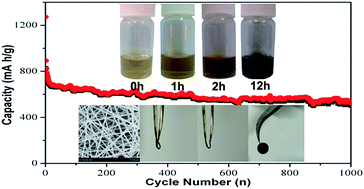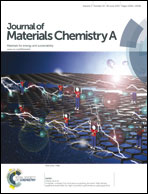Stannous ions reducing graphene oxide at room temperature to produce SnOx-porous, carbon-nanofiber flexible mats as binder-free anodes for lithium-ion batteries†
Abstract
Tin oxides with high theoretical capacities as anodes for lithium-ion batteries always suffer from the electrical disconnect issue of active materials owing to huge volume changes. In this work, flexible mats composed of ultra-small SnOx nanoparticles, graphene, and carbon fibers are synthesized by reducing graphene oxide with stannous ions at room temperature following treatments. SnOx nanoparticles, including SnO and SnO2, with diameters of approximately 4 nm are embedded in the matrix composed of carbon fiber and graphene to form composite fibers that are woven into flexible mats without any binders. As binder-free anodes for lithium-ion batteries, SnOx–graphene–carbon fiber mats can deliver a high reversible capacity of 545 mA h g−1 after 1000 cycles at a current density of 200 mA g−1, which is much better than those of SnOx–carbon fiber mats. The improved performance of SnOx–graphene–carbon fiber mats can be attributed to the ultra-small size of SnOx nanoparticles and the double protection of both graphene and carbon fibers.


 Please wait while we load your content...
Please wait while we load your content...